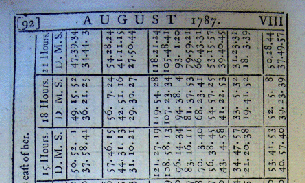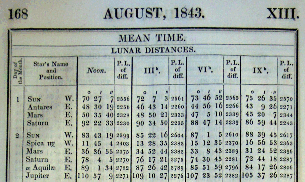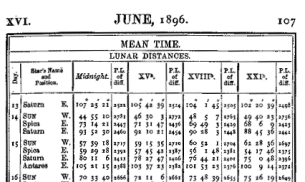
(click for the full page)
Lunars in the Nautical Almanac
Starting in 1767, under the direction of Nevil Maskelyne, the astronomers and calculating teams at the Greenwich Observatory in Britain east of London began publishing tables of lunar distances along with other necessary astronomical data in the "Nautical Almanac". Without these pre-calculated, geocentric lunar distances, the lunar method of finding longitude would have been nearly useless. Although it was possible for a team of highly skilled navigators at sea to calculate lunar positions directly, it was far simpler for Greenwich to calculate and compile these tables for sale to mariners. The almanacs were the first viable solution to the problem of navigating safely and efficiently across the world's oceans, and the Nautical Almanac is still being published even today.
The sample page below shows lunar distance tables from the Nautical Almanac
of 1787. It tabulates distances from the Moon to the Sun as well as the nine
"lunars stars" for every three hours of the day (based on Greenwich Local
Apparent Time). For a brief period, a tenth lunars star, β Capricorni,
was included in the list, but this star proved impractical, most likely because
it is faint and difficult to identify. The nine lunars stars with their prefered
old names and prefered modern names:
| Old Name | Modern Name | Constellation | |
| α Arietis Aldebaran Pollux Regulus Spica Virginis Antares α Aquilae Fomalhaut α Pegasi |
Hamal Aldebaran Pollux Regulus Spica Antares Altair Fomalhaut Markab |
Aries Taurus Gemini Leo Virgo Scorpius Aquila Piscis Austrinus Pegasus |
Beginning in 1834, the lunar distance tables in the Nautical Almanac were updated reflecting improvements in calculations of ephemeris data for the planets and changes in time standards. In addition to lunar distances measured from the Sun and the nine lunars stars, geocentric lunar distances were included for the bright planets: Venus, Mars, Jupiter, and Saturn. As in earlier almanacs, the lunar distances were listed every three hours, though the times were now hours of Greenwich Mean Time. There were no further changes in the select group of objects designated for shooting lunars in the remainder of their history in the almanacs. The lunars tables were not dropped from the US "American Ephemeris & Nautical Almanac" until 1912, a few years after they were eliminated from most other almanacs worldwide.
A sample lunars page from the Nautical Almanac of 1843:

(click for the full page)
And a page from 1896:

(click for the full page)
Note that there have been no apparent changes in the lunars tables from 1843 to 1896. This may be a reflection of their limited practical usefulness in this later period. There are subtle improvements. The position of the Moon is more accurate in this later period.
The lunar distance calculator (ver. 5) on this web site calculates accurate almanac data directly and can produce lunars tables comparable to the old Nautical Almanacs for any date between 1750 and 2050.